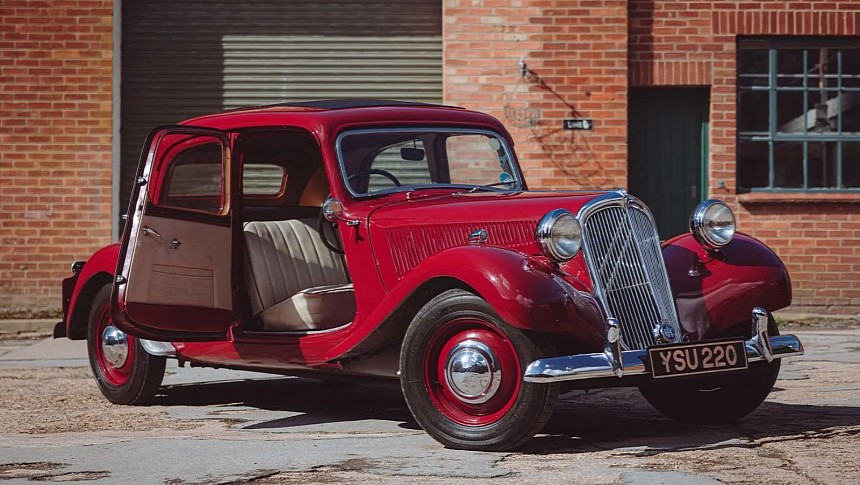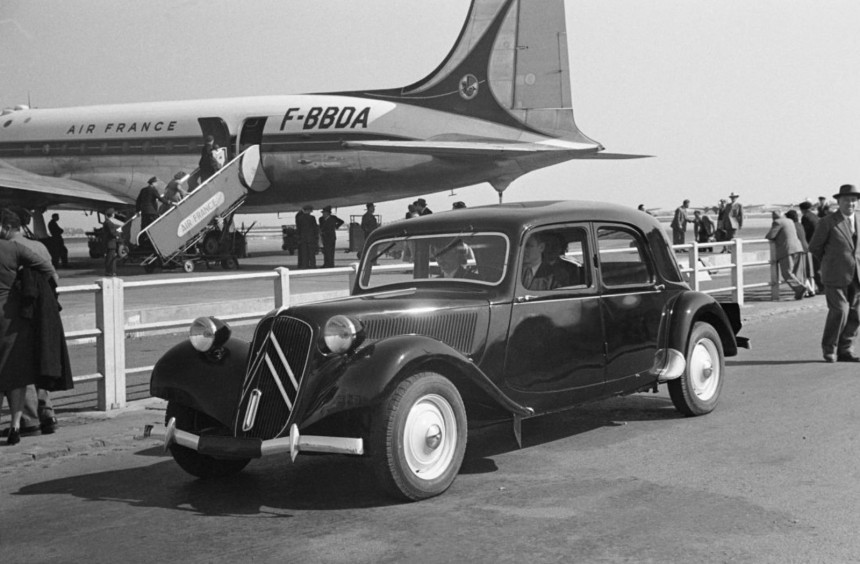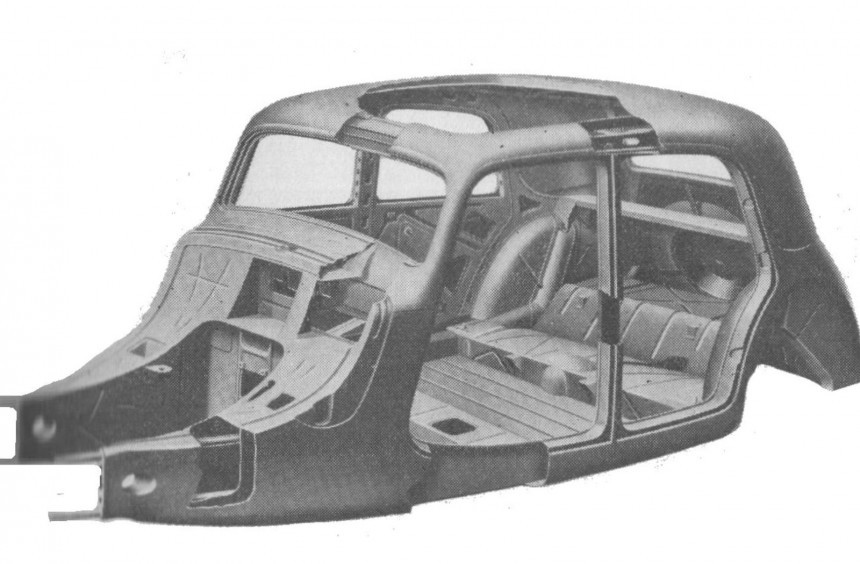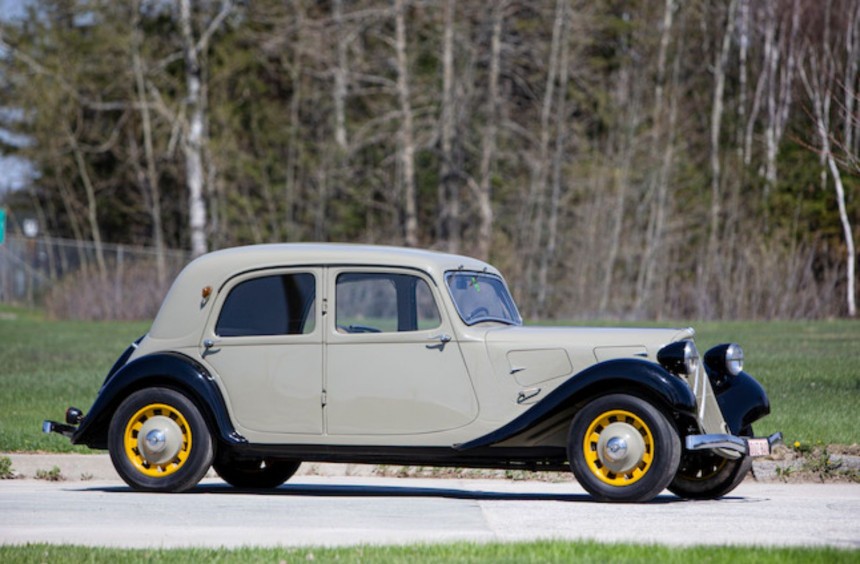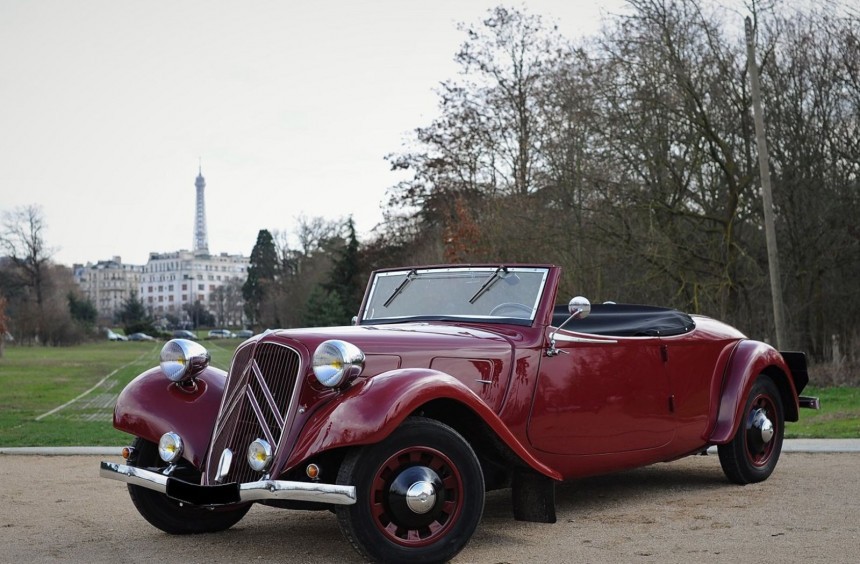Although it looks like an ordinary car from the 1930s, the Traction Avant was arguably the most innovative car of its era. It effectively created the recipe for modern cars by introducing the unibody chassis and advancing technologies like independent suspension, hydraulic brakes, or rack and pinion steering on a regular mass-production vehicle.
Now part of the Stellantis corporate umbrella, Automobiles Citroen was founded in 1919 by Andre Citroen - a French industrialist who made a fortune by manufacturing weapons during the First World War.
In just a few decades, it grew from a small company to one of Europe's most renown carmakers, pioneering technologies like the hydraulic suspension system and developing the DS - one of the most influential cars of the 20th century.
But before introducing the DS, Citroen made its mark on the automotive industry with the Traction Avant (French for front traction), the world's first mass-produced vehicle that combined a unibody chassis with front-wheel-drive.
Following Henry Ford's footsteps, Andre Citroen wanted to take the notion of a mass-produced vehicle to another level and revolutionize his company's lineup by developing a car that was both innovative and cheap to manufacture.
He laid out the objective to his employees, then French engineer Andre Lefebvre and Italian-born designer Flaminio Bertoni stepped up by creating the initial plans for the Traction Avant.
Suggesting that they could squeeze in advanced tech into a lighter (and thus cheaper) one-piece chassis, the two employees and their team built a prototype in early-1934.
Realizing that this would be a winning formula, Andre Citroen ordered the demolition of one of the company's older plants and greenlighted the construction of a new facility dedicated to assembling the new model, which took only about six months to finish.
The basis for the revolutionary car was the unibody chassis, which, contrary to popular belief, was not a patented Citroen design.
The idea was pioneered in the US by Joseph Ledwinka of the Budd Company - a metal fabricator that produced stainless steel rail carts and supplied various components to the automotive, aircraft, and defense industries.
Commonplace today, unibody construction proposed fuzing the frame and bodywork into a single structure, which would result in a lighter and stiffer car, would give designers more flexibility, and, more importantly, would slash production costs.
Budd presented the unibody concept to Detroit's biggest carmakers with little success. Citroen was the only carmaker who saw its potential and eventually purchased the rights to the design.
It's also worth noting that Lancia used a crude form of unibody construction on its 1922 Lancia Lambda. Still, without a stressed roof, it was more of a bowl-type integrated chassis than a genuine unibody.
Though it wasn't the first mass-produced vehicle to feature front-wheel-drive, the Traction Avant was the first to offer this drivetrain with a unibody chassis. FWD gained more popularity during the 1960s, and, combined with a transversely-mounted engine, it continues to be the most widely-used layout today.
When first introduced in 1934, the Traction Avant was powered by a longitudinally-mounted, 1.3-liter inline-four linked to a three-speed manual transaxle gearbox.
Using a lightweight yet sturdy aluminum alloy casing, the transaxle was used by John Cooper in his mid-engine T43 and T45 race cars that revolutionized Formula 1.
In the Traction Avant, the gearbox was positioned at the front of the vehicle, with the engine behind it and a differential between the two units. This resulted in excellent weight distribution and thus improved handling characteristics.
The car's road manners were further improved with the use of an advanced suspension setup. At the front, the wheels were independently sprung using a torsion bar and wishbones, whereas, at the rear, it used a steel beam axle with Panhard rods, trailing arms, and torsion bars.
In 1956, it was also used as a testbed for Citroen's patented Hydropneumatic suspension system - albeit fitted only to the rear axle. This system was used on all four wheels on the iconic DS, and even today, it's considered Citroen's most significant innovation.
The Reine de la Route (Queen of the Road, as it was nicknamed in France) furthered the advancement of rack and pinion steering from 1936 onwards. Moreover, it utilized hydraulic drum breaks in an era when most production cars still used a cable-operated system.
Though Traction Avant became synonymous with the model line, that was never its official name. Throughout its lifespan, the car was called Citroen 7, 11, or 15/6 in France, depending on its engine output and displacement. In the UK, it was marketed with more appealing names like Light Twelve, Light Fifteen, Big Fifteen, or Big Six.
Initially, it was available only as a small four-door sedan with a 115-inch (2,910 mm) wheelbase and a modest four-cylinder displacing 1.3 liters.
By 1934, a larger, 1.9-liter engine was introduced. Apart from the small four-door body known as Legere (light), a new one called Normale (normal) was added to the lineup. It was noticeably larger and wider than the conventional version, transforming the Traction Avant into a normal, full-size car.
The carmaker also revealed the Familiale (family) and Commerciale (commercial) versions that year. The first debuted a three-row seating arrangement capable of accommodating up to 9 passengers, while the second had increased trunk space and a big rear-opening hatch that made it the world's first mass-produced hatchback.
The four-door models were joined by a limited number of two-door coupes and convertibles during the late-1930s. However, Citroen removed them from the lineup when production resumed after the Second World War.
In 1939, the most powerful version of the Traction Avant was introduced. Based on the Normale but boasting several cosmetic improvements, the new model called 15/6 (or Big Six in the UK) received a 2.8-liter inline-six.
The Traction Avant was built from 1934 to 1957 (with a pause caused by WWII) in approximately 760,000 units. They were assembled in France, as well as in Belgium, Germany, Denmark, and England.
Even though it significantly impacted the automotive industry, this model is largely forgotten today. Therefore, surviving sedans have an average value of around $25,000, according to classics.com.
However, the rare two-door coupes and convertibles are highly sought-after by collectors, and their value goes up in the six-digit category.
If you want to learn more about this French icon and see it roaming the streets of New York, watch the Jay Leno's Garage episode below.
In just a few decades, it grew from a small company to one of Europe's most renown carmakers, pioneering technologies like the hydraulic suspension system and developing the DS - one of the most influential cars of the 20th century.
But before introducing the DS, Citroen made its mark on the automotive industry with the Traction Avant (French for front traction), the world's first mass-produced vehicle that combined a unibody chassis with front-wheel-drive.
Revolutionizing the brand and the automotive industry
He laid out the objective to his employees, then French engineer Andre Lefebvre and Italian-born designer Flaminio Bertoni stepped up by creating the initial plans for the Traction Avant.
Suggesting that they could squeeze in advanced tech into a lighter (and thus cheaper) one-piece chassis, the two employees and their team built a prototype in early-1934.
Realizing that this would be a winning formula, Andre Citroen ordered the demolition of one of the company's older plants and greenlighted the construction of a new facility dedicated to assembling the new model, which took only about six months to finish.
A unibody design that originated in the US
The idea was pioneered in the US by Joseph Ledwinka of the Budd Company - a metal fabricator that produced stainless steel rail carts and supplied various components to the automotive, aircraft, and defense industries.
Commonplace today, unibody construction proposed fuzing the frame and bodywork into a single structure, which would result in a lighter and stiffer car, would give designers more flexibility, and, more importantly, would slash production costs.
Budd presented the unibody concept to Detroit's biggest carmakers with little success. Citroen was the only carmaker who saw its potential and eventually purchased the rights to the design.
It's also worth noting that Lancia used a crude form of unibody construction on its 1922 Lancia Lambda. Still, without a stressed roof, it was more of a bowl-type integrated chassis than a genuine unibody.
A comprehensive list of advanced tech bundled up in one car
When first introduced in 1934, the Traction Avant was powered by a longitudinally-mounted, 1.3-liter inline-four linked to a three-speed manual transaxle gearbox.
Using a lightweight yet sturdy aluminum alloy casing, the transaxle was used by John Cooper in his mid-engine T43 and T45 race cars that revolutionized Formula 1.
In the Traction Avant, the gearbox was positioned at the front of the vehicle, with the engine behind it and a differential between the two units. This resulted in excellent weight distribution and thus improved handling characteristics.
The car's road manners were further improved with the use of an advanced suspension setup. At the front, the wheels were independently sprung using a torsion bar and wishbones, whereas, at the rear, it used a steel beam axle with Panhard rods, trailing arms, and torsion bars.
In 1956, it was also used as a testbed for Citroen's patented Hydropneumatic suspension system - albeit fitted only to the rear axle. This system was used on all four wheels on the iconic DS, and even today, it's considered Citroen's most significant innovation.
The Reine de la Route (Queen of the Road, as it was nicknamed in France) furthered the advancement of rack and pinion steering from 1936 onwards. Moreover, it utilized hydraulic drum breaks in an era when most production cars still used a cable-operated system.
Model history
Initially, it was available only as a small four-door sedan with a 115-inch (2,910 mm) wheelbase and a modest four-cylinder displacing 1.3 liters.
By 1934, a larger, 1.9-liter engine was introduced. Apart from the small four-door body known as Legere (light), a new one called Normale (normal) was added to the lineup. It was noticeably larger and wider than the conventional version, transforming the Traction Avant into a normal, full-size car.
The carmaker also revealed the Familiale (family) and Commerciale (commercial) versions that year. The first debuted a three-row seating arrangement capable of accommodating up to 9 passengers, while the second had increased trunk space and a big rear-opening hatch that made it the world's first mass-produced hatchback.
The four-door models were joined by a limited number of two-door coupes and convertibles during the late-1930s. However, Citroen removed them from the lineup when production resumed after the Second World War.
In 1939, the most powerful version of the Traction Avant was introduced. Based on the Normale but boasting several cosmetic improvements, the new model called 15/6 (or Big Six in the UK) received a 2.8-liter inline-six.
The Traction Avant today
Even though it significantly impacted the automotive industry, this model is largely forgotten today. Therefore, surviving sedans have an average value of around $25,000, according to classics.com.
However, the rare two-door coupes and convertibles are highly sought-after by collectors, and their value goes up in the six-digit category.
If you want to learn more about this French icon and see it roaming the streets of New York, watch the Jay Leno's Garage episode below.
